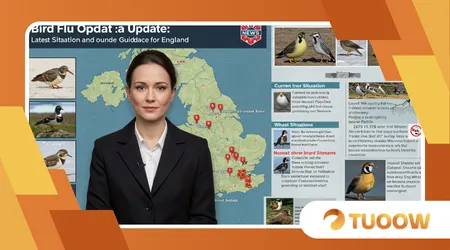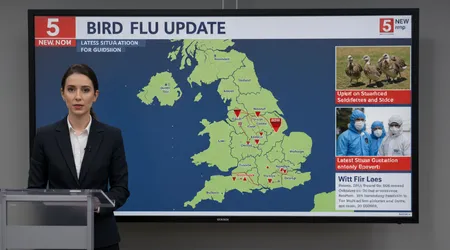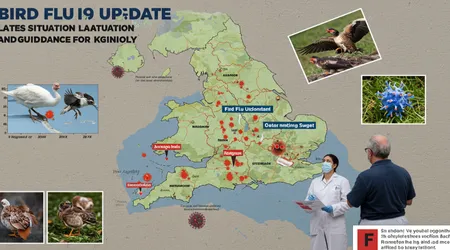Bird Flu Update: Latest Situation and Guidance for England

Bird flu update: England faces a heightened avian influenza challenge in 2025, with H5N1 cases surging in poultry and wild birds.
Authorities, led by the Department for Environment, Food and Rural Affairs (Defra), have rolled out stringent measures to curb the spread, while the UK Health Security Agency (UKHSA) monitors human risks.
This article unpacks the current situation, offering clear guidance for bird keepers and the public.
Why should you care?
Because this isn’t just about birds it’s about food security, public health, and resilience.
Let’s dive into the facts, sidestepping the panic, and explore what’s at stake with practical steps to stay safe.
The H5N1 strain, notorious for its high pathogenicity, has triggered alarms across England.
From Yorkshire’s poultry farms to Cumbria’s wild bird populations, outbreaks are testing the nation’s biosecurity.
Defra’s latest reports confirm cases in commercial flocks, with over 1.6 million hens culled in Shropshire alone in January 2025.
The UKHSA’s first annual report, published March 25, 2025, flagged H5N1 as an “emerging infection,” noting one human case in January but no sustained human-to-human transmission.
This is a relief, but vigilance remains critical. The virus’s ability to jump species sheep in Yorkshire tested positive raises questions about its evolution. Are we prepared for what’s next?
This bird flu update isn’t just a headline; it’s a call to action. Bird keepers, farmers, and even pet owners must act swiftly to protect their flocks and communities.
The public, too, plays a role simple habits like avoiding contact with wild birds can make a difference.
Below, we’ll break down the situation, guidance, and practical steps, weaving in real-time data and expert insights. Let’s navigate this crisis with clarity and purpose.
Current State of Avian Influenza in England
England’s battle with H5N1 intensified in early 2025, with outbreaks reported across multiple regions.
Defra confirmed cases near Blaydon, Durham, and Pickering, North Yorkshire, in March, leading to culls and surveillance zones.
The virus, primarily affecting poultry, has also infected wild birds, complicating containment.
A bird flu update from Defra on April 4 extended housing measures in Cumbria, Durham, Northumberland, and Tyneside, mandating indoor keeping to curb spread.
The scale is staggering: over 1 million birds were culled at a Shropshire farm in January, per BBC News. Wild bird infections, especially in coastal areas, signal a broader ecological threat.
The UKHSA notes H5N1’s presence in a Yorkshire sheep, hinting at cross-species risks.
While human cases remain rare one confirmed in January 2025 the virus’s 50% global mortality rate in humans, as cited by Dr. Kay Russo on CBS News, demands attention.
This isn’t a distant problem. Imagine a domino effect: infected flocks disrupt egg supplies, as seen in Chicago’s Trader Joe’s in January.
England’s poultry industry faces similar risks, with economic ripple effects. The bird flu update underscores urgency biosecurity isn’t optional.
++ Government Launches AI Growth Zones and Green Jobs Training
Farmers must act, and the public must stay informed to avoid amplifying the crisis.
Surveillance zones, like the 10km radius around Blaydon, are now commonplace.
These zones restrict bird movement and enforce testing, per Defra’s protocols. But containment is tricky wild birds don’t respect boundaries.
The virus’s spread to mammals, like the Yorkshire sheep, suggests it’s adapting.
This bird flu update calls for proactive measures, not just reaction. Are we doing enough to stay ahead of H5N1’s curve?

Updated Guidance for Bird Keepers
Defra’s latest guidance, issued April 2025, is a lifeline for bird keepers. All poultry and captive birds in high-risk areas Cumbria, Durham, Northumberland, Tyneside must be housed indoors.
This bird flu update emphasizes biosecurity: clean equipment, limit visitors, and monitor flocks for symptoms like lethargy or respiratory distress.
Also read: UK Becomes First European Country to Ban SIM Farm Devices to Combat Fraud
Report suspicions to Defra’s helpline (03000 200 301) immediately.
Practical steps are non-negotiable. For example, a Yorkshire farmer, Jane, saved her flock by installing netting over coops and disinfecting daily.
Contrast this with a Northumberland keeper who lost 200 hens due to lax measures.
The Avian Influenza Prevention Zone (AIPZ), extended in April, mandates enhanced biosecurity nationwide. Small flock owners, like pet chicken enthusiasts, must comply too.
| Measure | Details | Applies To |
|---|---|---|
| Housing | Keep birds indoors | High-risk areas (e.g., Cumbria) |
| Biosecurity | Disinfect equipment, limit access | All bird keepers |
| Surveillance | Report symptoms to Defra | Nationwide |
Neglecting guidance risks devastation. A single infected bird can trigger a cull, as seen in Shropshire’s million-hen loss.
This bird flu update urges keepers to act swiftly your flock’s survival depends on it. Backyard owners, don’t assume you’re exempt; one sick hen can spark an outbreak.
Read more: UK Counter-Terror Police Probe Kneecap Band Over Hamas and Tory Remarks
Training is another layer of defense. Defra offers online resources for spotting H5N1 symptoms, like sudden deaths or egg production drops.
A Cumbrian farmer, Tom, credits these tools for catching an outbreak early, saving half his flock. This bird flu update isn’t just policy it’s a toolkit for resilience. Are you ready to protect your birds?
Public Health Implications and Precautions
The UKHSA’s March 2025 report confirms H5N1’s low public health risk, with no human-to-human transmission.
Yet, one human case in January and asymptomatic infections among poultry workers signal caution.
This bird flu update advises avoiding contact with sick or dead birds wild or domestic. Wash hands thoroughly after handling poultry.
Public vigilance is key. In Brighton, a beachgoer reported dead gulls, leading to swift testing and containment.
Compare this to Chicago, where delayed reporting worsened a Lake Michigan outbreak.
The UKHSA recommends flu vaccinations to reduce co-infection risks, as H5N1 could recombine with human flu strains, per The Conversation’s March 2025 analysis.
Think of H5N1 like a spark in dry grass one misstep could ignite a fire. The virus’s 50% global mortality rate, though not reflective of England’s single case, underscores its potential.
This bird flu update encourages simple habits: don’t touch wild birds, and report sightings to local authorities. These actions protect communities.
Pet owners, take note. Cats exposed to infected birds, like one in San Bernardino, California, in 2025, can contract H5N1. Keep pets away from poultry and wild birds.
The CDC’s April 2025 guidance on cats reinforces this. This bird flu update isn’t alarmist it’s a nudge to stay proactive and keep risks low.
Economic and Food Security Concerns
H5N1’s ripple effects threaten England’s food supply. The Shropshire cull of 1.6 million hens in January 2025, reported by BBC, slashed egg production, mirroring U.S. shortages.
This bird flu update highlights poultry industry losses, with farmers facing financial ruin. Consumers may see egg and poultry prices spike.
The analogy is stark: H5N1 is a wrecking ball to agriculture. A single outbreak can shutter farms, disrupt supply chains, and inflate costs.
Defra’s £1 billion bird flu plan, per POLITICO, diverts funds from schools and food banks, sparking debate. Economic strain is real farmers need support, not just culls.
Small farms are hit hardest. In Durham, a family-run poultry business lost 80% of its flock, forcing layoffs. Contrast this with large producers, who absorb losses better.
This bird flu update calls for targeted aid grants or insurance to protect vulnerable farmers and stabilize food security.
Policy gaps exacerbate the crisis. Staff cuts at the USDA and FDA, reported by Reuters in April 2025, weakened U.S. testing, and England risks similar pitfalls.
Investing in surveillance and rapid response is critical. This bird flu update demands long-term planning to safeguard both farmers and consumers.

Global Context and Future Outlook
H5N1’s global footprint is alarming. Mexico reported its first human death a toddler in April 2025, per Reuters.
Poland faced 73 outbreaks, prompting EU emergency measures. England’s situation, while controlled, mirrors this global uptick.
This bird flu update urges international cooperation to track and contain the virus.
The virus’s evolution is a wildcard. The Conversation notes H5N1’s potential for genetic reshuffling, risking human transmissibility.
England’s surveillance, like the UKHSA’s worker testing, is robust but stretched. Staff cuts, as seen in the U.S., could weaken defenses. Are we investing enough in prevention?
Hope lies in science. Vaccines for poultry, trialed in Europe, could reduce culls. England’s research, backed by Defra, explores similar solutions.
This bird flu update envisions a future where technology outpaces H5N1’s spread, but only with sustained funding and global collaboration.
Conclusion: A Collective Responsibility
This bird flu update reveals a complex crisis H5N1 threatens birds, farmers, and food security, with faint but real human risks.
England’s response, from Defra’s housing mandates to UKHSA’s surveillance, is proactive but not infallible.
Bird keepers must fortify biosecurity; the public must stay vigilant. Think of it like a village watch everyone’s role matters.
The stakes are high: 1.6 million birds culled in Shropshire alone prove the virus’s toll. Yet, panic isn’t the answer.
Practical steps housing birds, avoiding wild bird contact, supporting farmers can stem the tide. This bird flu update is your guide to act, not just read. Will you step up to protect your community?
England’s resilience hinges on collective action. Share this knowledge, report sick birds, and demand robust policies.
H5N1 isn’t invincible, but complacency is its ally. Let’s outsmart this virus together, ensuring safety for flocks, families, and food supplies in 2025 and beyond.
Frequently Asked Questions
Q: Can I catch bird flu from eating poultry or eggs?
A: No, properly cooked poultry and eggs are safe. The UKHSA confirms H5N1 isn’t foodborne. Always cook thoroughly to eliminate risks.
Q: What should I do if I find a dead wild bird?
A: Don’t touch it. Report it to Defra’s helpline (03000 200 301). This helps track outbreaks and protect local flocks.
